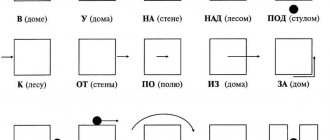Modern parents know that in order to successfully study at school, children need to clearly and clearly pronounce all the sounds of their native language. Without correct speech, it is impossible to express your thoughts, write dictations, or compose retellings. Usually, by school, a child should have well-developed speech. However, some preschoolers never learn to speak clearly and distort some sounds, so it becomes necessary to consult a speech therapist. Experts note that recently new types of dyslalia (sound pronunciation disorders) have appeared, which were almost never encountered before. These include incorrect pronunciation of the sounds T, D. Will parents be able to work on correcting sound pronunciation at home if such a speech disorder is discovered in a child? In order to properly organize classes at home, you need to understand what the production of the t sound is in connection with the production of the d sound.
Important: correct pronunciation develops mainly by the age of five, so you should seek special help after 5 years. However, from an early age it is necessary to carefully monitor the child’s speech, not to be touched by the distortion of words, but, if possible, to correct the child’s speech errors.
Preparatory exercises
Speech therapy deals with the study, prevention and elimination of speech defects. It is necessary to teach articulation at the earliest stages of life, starting with preparatory exercises.
Speech elements appear at 2-3 months during “walking”. The child sings sounds. It is necessary to talk to him more, sing songs, lullabies, trying to draw out vowel sounds so that the baby quickly remembers and repeats them.
Speech skills depend on physical development. Many parents pay great attention to fine motor skills, allowing the baby to hold small objects.
You should communicate without babying: the child’s speech depends on how correctly and beautifully the adult speaks.
Speech therapists advise strengthening the muscles of the oral cavity, teach how to control the articulatory apparatus, showing the differences in pronunciation: T is at the tip, K is at the tail of the tongue: “The taxi is coming,” “A bag of sweets.”
Regulatory framework
Submission of the SZV-TD form is regulated by:
- Federal Law of December 16, 2019 No. 436-FZ “On Amendments to the Federal Law “On Individual (Personified) Accounting in the Compulsory Pension Insurance System.”
- Federal Law of December 16, 2019 No. 439-FZ “On amendments to the Labor Code of the Russian Federation (regarding the generation of information about labor activity in electronic form).”
- Resolution of the Board of the Pension Fund of the Russian Federation dated December 25, 2019 No. 730p “On approval of the form and format of information on the labor activity of a registered person, as well as the procedure for filling out the forms of the specified information” (together with the “Procedure for filling out the form “Information on the labor activity of a registered person (SZV-TD)" ", "Format of information for the form "Information on labor activity (SZV-TD) of a registered person" in electronic form").
Articulation gymnastics
Experts suggest using speech therapy techniques to develop speech breathing (since T is formed during explosive exhalation), and to train the muscles of the oral cavity in a playful way:
- “Whose dandelion will fly away first?” — in the summer, at the dacha, the guys pick dandelions and try to blow away all the fluff in 3-4 times.
- “Balloons” - blow on the balloons, preventing them from falling to the floor.
- “Smile” - close your teeth, stretch your lips wide, hold a smile for 5 seconds.
- “Punish the tongue” - put the tongue on the lower lip, tap on it with the upper lip: pa-pa-pa.
- “Spatula” - smile, stick out tongue, relax, place on lower lip, hold for 5 seconds.
- “Tick-tock clock” - quickly move the tip left and right along the upper lip.
- “We’re brushing our teeth,” they smile. The tongue “goes around” all the teeth from left to right and back.
- “Tube” - stretch the tongue as much as possible, tense it. They try to roll it into a tube and hold it for 5 seconds.
- “Swing” - open your mouth slightly, alternately pull your tongue towards your nose and chin, trying to reach them.
- “Slide” - first, the front edge is firmly pressed against the lower incisors, then the wide part (at the same time it bends). Fix the position for 5 seconds.
Who is required to take the SZV-TD and when?
Starting from 2022, a new personalized accounting reporting document has been approved, which employers are required to submit to the Pension Fund. This is a SZV-TD report, which is called “ Information on the work activity of a registered person .” The form of the form, the procedure and instructions for generating data for each employee were approved by Resolution 730p of December 25, 2022. From 07/01/2021. changes introduced by the Resolution of the Board of the Pension Fund of October 27, 2020 came into effect. No. 769p.
SZV-TD is formed for each employee with whom the policyholder has entered into an employment contract, including those who work remotely or part-time.
Starting from January 1, 2022, the conditions for submitting a report in the SZV-TD form are:
- transfer of an employee to another permanent job, filing an application to continue maintaining a work record book or providing information about work activity - no later than the 15th day of the month following the month in which the specified personnel events took place
- when hiring (dismissing) – submission deadline no later than the next working day
Should I submit a SZV-TD if employees have chosen paper work reports?
A statement about the employee’s choice of the format for maintaining a work record book (paper or electronic) is already the basis for submitting a SZV-TD. The employer is obliged to report to the Pension Fund of the Russian Federation on the work activities of its employees and promptly submit electronic information using the new form. This norm is enshrined in 436-FZ of December 16, 2022.
Is it necessary for an individual entrepreneur without employees to take the SZV-TD?
The electronic document SZV-TD is presented exclusively in relation to hired employees , and only for those who had personnel events . Therefore, an entrepreneur without employees should not transfer the document to the Pension Fund.
Making sounds T and D
When teaching correct pronunciation, they use the method of imitation, mechanical, from other sounds.
- By imitation. Show how the tongue is positioned. Note that T has no voice. Ask to say: ta, you, tu. Then pure words: ta - ta, oh, what a beauty; tu-tu, I’ll braid my hair; now and then, the sieve is leaky; you - you, flowers have grown in the garden.
- Mechanical. Show the position of the tongue between the teeth. Ask to say Ta. At this time, use a spatula to lift your upper lip. The tongue will take the correct position.
- "Spitting." Offer to smile, close your teeth, if the tip of your tongue rests on the lower incisors, exhale - T.
- Setting T: from P - when pronouncing pa-pa-pa, the edge of the tongue lies on the lower lip between the teeth, the mouth is slightly open - it turns out ta-ta; from D - similar to the production of T, but the voice is added;
- Setting D: from T - the specialist alternately pronounces the sounds D, T, the preschooler holds his hand on his throat, the other touches the adult’s larynx, feels the vibration; from B - when pronouncing ba-ba-ba, the tip of the tongue is between the teeth; at the moment of pronouncing, we move our lips away with a spatula, we hear yes-da-da.
Deadline for submitting SZV-TD in 2022
From January 1, 2022, information on the work activities of employees is submitted monthly no later than the 15th day of the month following the reporting month. The exception is the hiring and dismissal of insured persons; a report on them is submitted no later than the working day following the day the relevant order (instruction) is issued.
Deadlines for submitting the form in case of personnel transfers:
| Reception | No later than the working day following the day of publication of the relevant order (instruction), other decision or document |
| Dismissal | |
| For other events | No later than the 15th day of the month following the reporting month |
Important! If an employee leaves work in the middle of the reporting period, the SZV-TD form should reflect not only information about the dismissal, but also about other personnel events of this month, as well as the past, if the form for the previous one was not submitted.
Automation of pronunciation
After articulation is established, the skill is practiced. Defects should be eliminated as quickly as possible without overloading the child. Each subsequent material must be offered after complete assimilation of what has been covered.
Various game exercises with songs, nursery rhymes, and tongue twisters will help you practice sounds, which will make children’s learning more interesting:
- Sing a song to your mother or grandmother: “Ta-ta, the cat has a fluffy tail...”.
- Play the drum for toys: tram-tam.
- Continue the word: decision, weather, flowers, nest.
- The fingers greet each other (the thumb greets the little finger, middle finger, thumb, index finger, saying tu, you, du, dy).
- We count Dalmatians: “The Dalmatian growled, He counted the spots, One, two, three, four, five, You can’t count them on your back!”
After automation, exercises are performed to consolidate the pronunciation of T, D in words.
- “Come up with words with T, D.” Adults name the words prepared on the cards with Ta at the beginning: plate, dance. The child continues: Tanya, slippers. With a ball, the activity will be even more interesting. Color the letter T in the pictures with one bright color and D with another.
- “Sounds T, D in a sentence.” The guys repeat the words, emphasizing T, D in their voices: Tamara is going home. A sperm whale swims. The snow has melted on the skating rink. The beautiful maiden sits in prison, and the braid is on the street. We can't understand Dasha. After all, Dasha has porridge in her mouth.
- Nursery rhymes, pure talk. Adults pronounce the first half of a short phrase, and the children come up with a rhyme that repeats the first syllable: Tu - tu, (I’ll catch some fish for the cat). That one, (oh, what a beauty). Yes, yes, (the beard darkened). Doo-doo, (I still won’t go).
Who and how should submit an application for maintaining a work record book?
During 2022, each employee has the right to choose the form of maintaining a work record book. If he wants to continue filling it out on paper, he must write a statement about this before January 1, 2022 .
Download the template: Application for choosing a method of maintaining a work record book.
If an employee chooses a paper form, he retains this right even in future employment with other employers. In addition, the insured person has the right to subsequently submit to the employer an “Application for Providing Information on Labor Activities.”
The employer is obliged to keep work books on paper for employees who submitted an application for this before January 1, 2022 and at the same time submit information on them electronically to the Pension Fund .
If an employee has chosen the electronic format for maintaining a work record, he must submit a special form during 2022: “Application for provision of information about work activities.” After this, the employer gives the employee a paper work record book with a record of the submitted application . From now on, the policyholder is no longer responsible for the paper document, and the employee cannot return to the paper format of maintaining a work record book.
In the SZV-TD form, you must indicate the date of filing such an application, therefore, it will also be reflected on the employee’s personal account with the Pension Fund of Russia, in addition, it will be indicated in all information about the length of service.
For employees who, for good reason, do not submit any applications by December 31, 2020, the employer will continue to maintain a paper work record book. Such employees include those who are on vacation (maternity leave), sick, or suspended from work.
Responsibility for failure to submit a new report
The employer or its official will be subject to administrative punishment for the following actions:
- for violation of reporting deadlines
- for submitting incomplete and (or) false information about work activities
| Primary violation | |
| Organization | from 30,000 to 50,000 rub. |
| Individual entrepreneurs | from 1,000 to 5,000 rubles. |
| Officials | from 1,000 to 5,000 rubles. |
| Repeated violation | |
| Organization | from 50,000 to 70,000 rub. |
| Individual entrepreneurs | from 10,000 to 20,000 rub. |
| Officials | from 10,000 to 20,000 rub. or disqualification for a period of 1 to 3 years |
For a primary violation, a warning may be issued instead of a fine.
If, as a result of an error in the report, the employee is unable to find employment in the future, the employer will be obliged to compensate him for the earnings lost due to the provision of false information.
How to edit or cancel a form
Information on choosing a paper or electronic form of a work book
The form contains a field for the date on which the application for the form of work record book chosen by the employee was submitted. If the information was entered incorrectly, you should submit another SZV-TD form for this employee with the correct date to the Pension Fund. There is no need to cancel the first form.
If it is necessary to cancel incorrectly submitted information about the choice by the insured person of the form of maintaining a work record book, you need to submit a repeat form, indicate the same date as in the first document, but in the field “Sign of.
Information about admission or dismissal, as well as transfer
In order to cancel a previously submitted form with incorrect information, you should submit another form with the fields filled out in the same way as the first report. Additionally, in the field “Indication of cancellation of recording information about admission, transfer, dismissal”, put an “ X ”.
To correct previously submitted information about work activity, you need to fill out a SZV-TD report with two lines:
- the first line is the same as in the original form, but in the column “Indication of cancellation of recording information about admission, transfer, dismissal” there is an “X” sign;
- the second line is with the correct data.








